Growing celery in the home garden provides crunchy snacks and flavor for homemade soups and stews. Celery will provide a harvest – both leaves and stems – for months (or even a couple of years) making it a worthwhile addition to your garden plans.
Swiss chard is another great vegetable to grow in containers that will provide a long harvest season.
Originally published in May 2019; this post has been updated.
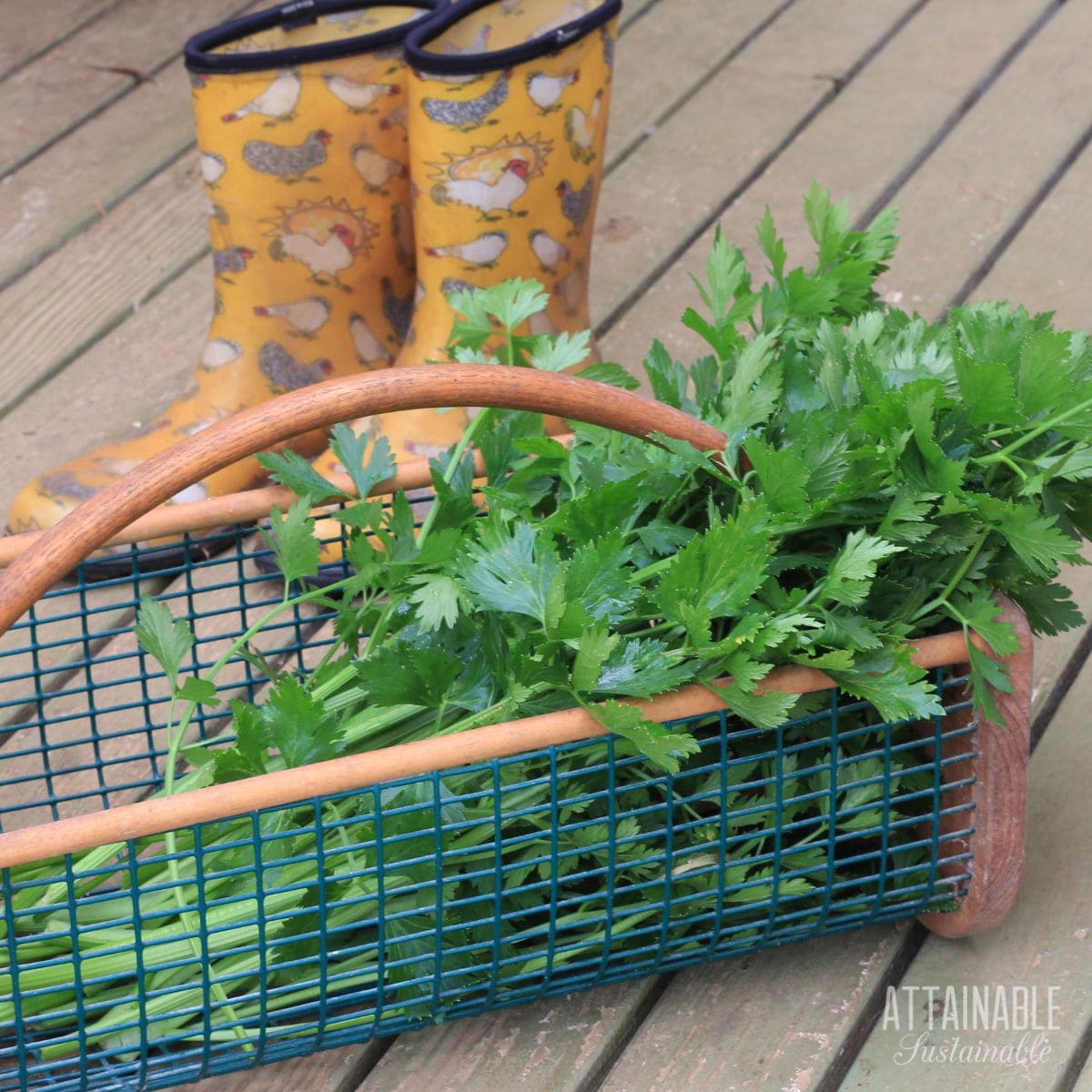
Introduction to Growing Celery
Crunchy green celery is a familiar vegetable to most of us, but it seems like it’s not commonly planted in backyard gardens. I’m here to change that! I love having celery growing in my garden both for its usefulness in cooking and its sheer beauty. It grows one-to-two feet tall and the celery leaves are beautiful foliage. It’s a great addition to front yard gardens.
Celery Varieties
There are not a lot of common named varieties of celery. Unlike crops like tomatoes and beans that come in more colors and options than you can count, you won’t be faced with such daunting decisions when growing celery.
- Conquistador tolerates more heat than some varieties.
- Tango has less fibrous stalks than Conquistador, and some say a better flavor.
- Chinese pink celery will give you something to talk about with its pretty stalks.
Grow Some Greens!
Ready to grow fresh greens, no matter WHERE you live? Sign up for my
FREE quick-start guide and start growing some of your own food!
How to Plant Celery
Celery seedlings aren’t commonly available at garden centers, so you’ll probably have to grow it from seed. Celery should be started from seed 10-12 weeks before the average last frost date for spring planting.
For a fall harvest, start seed during the summer, 10-12 weeks before the first fall frost. Soaking seeds overnight before planting them can improve germination. Celery seeds are small and are best sprinkled onto seed starter mix and gently pressed into the soil; there’s no need to cover the seeds.
Plant seedlings out in the garden when the soil reaches 50 degrees and nighttime temps remain above 40. Allow about 10″ between plants, adding mulch around the base of each plant to help retain moisture.
If (like mine) your climate allows you to direct sow celery, I’ve had good luck with broadcasting seeds over a fresh layer of compost.
Requirements for Growing Celery
Celery is best planted in the spring or fall; it doesn’t do well in the heat of the summer. It takes 130-140 days to mature; plan your planting accordingly, so that it matures before the weather becomes unbearably hot. This is not a good option for veggie gardens facing drought conditions.
Water Requirements
Celery is a thirsty crop that demands regular water. Without it, it can become stringy and hollow. Still edible, certainly, but not lovely.
Soil Requirements
Plant celery in nutrient-rich soil — it’s a heavy feeder. Add a side-dressing of compost near the base of the plants every three weeks or so.
Combating Pests and Other Problems
Homegrown celery needs a consistent source of water or the stalks will grow hollow. All that moisture, though, is a siren call for slugs and snails who like to hide in the tightly clumped stalks.
How to Grow Celery in Containers
Celery is shallow-rooted, and perfectly suited to container gardening. Choose a container that’s about 10″-to-18″ inches in diameter. A pot on the smaller end of this spectrum is large enough for one or two celery plants. Choose a large one and you can grow three or four.
Fill your container with rich soil. If you use a potting mix, incorporate some good-quality compost. Transplant seedlings or direct sow seeds following the guidelines above.
Harvesting Celery
This veggie is one that fits in the “cut and come again” category. Commercial growers harvest the entire plant, cutting it off at the base. Home gardeners can harvest from a single celery crop as long as the plant doesn’t succumb to hot weather. In my mild climate, I can grow and harvest celery in this manner all season long.
It’s easy to pop out to the garden and snip off several stalks as needed for recipes. This makes for less waste, too, since you’ll harvest just what you need. No celery going limp in the produce bin!
To harvest celery, use scissors to snip off the mature stalks on the outer portion of the plant. Take just what you need for your recipe and leave the rest of the plant in place; new stalks will continue to emerge. To harvest celery at the end of its season, use a sharp knife to cut the entire plant away from the roots.
Wintering Over
Celery is a biennial. In zones 5-6 and above, celery can be wintered over.
Using Celery
I’ve found that my homegrown celery has great flavor, but can tend toward being a bit tough for fresh eating. Which really? Is fine with me because while I use celery in recipes a lot, I rarely eat it raw.
Celery is an ingredient in the holy trinity and mirepoix. These cooking terms refer to combinations of vegetables used as a base in so many recipes. The holy trinity is commonly used in Cajun food and features celery, onions, and bell pepper. A mirepoix is often used as a base for soups and includes celery, onions, and carrots.
Are Celery Leaves Edible?
Absolutely! They’re flavorful and nutritious and it would be silly to discard them. I tend to use the entire stalk all at once, chopping everything to add to recipes. If you have a recipe that would be weird with celery leaves in it (though I’m not sure what that would be), remove the leaves from the stalk and save them for another recipe.

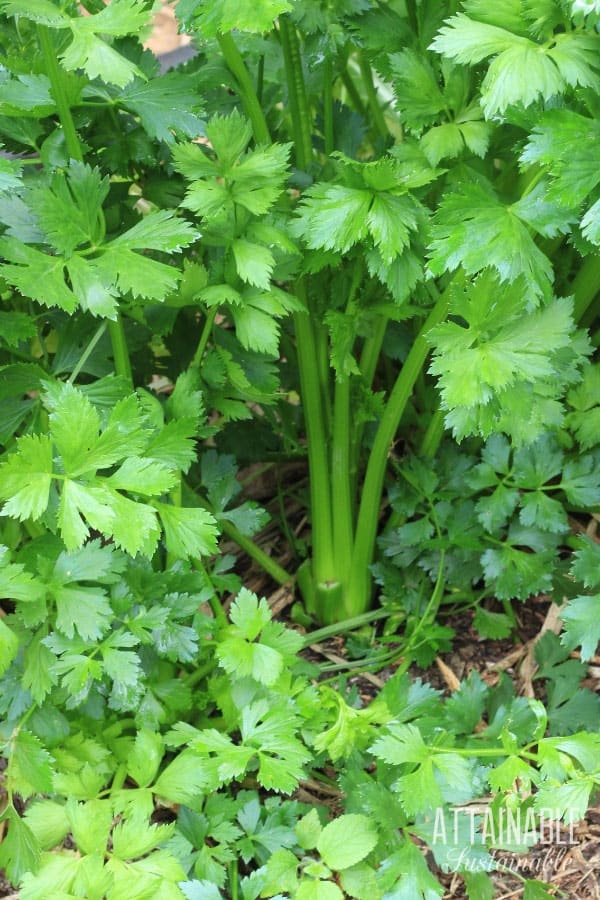
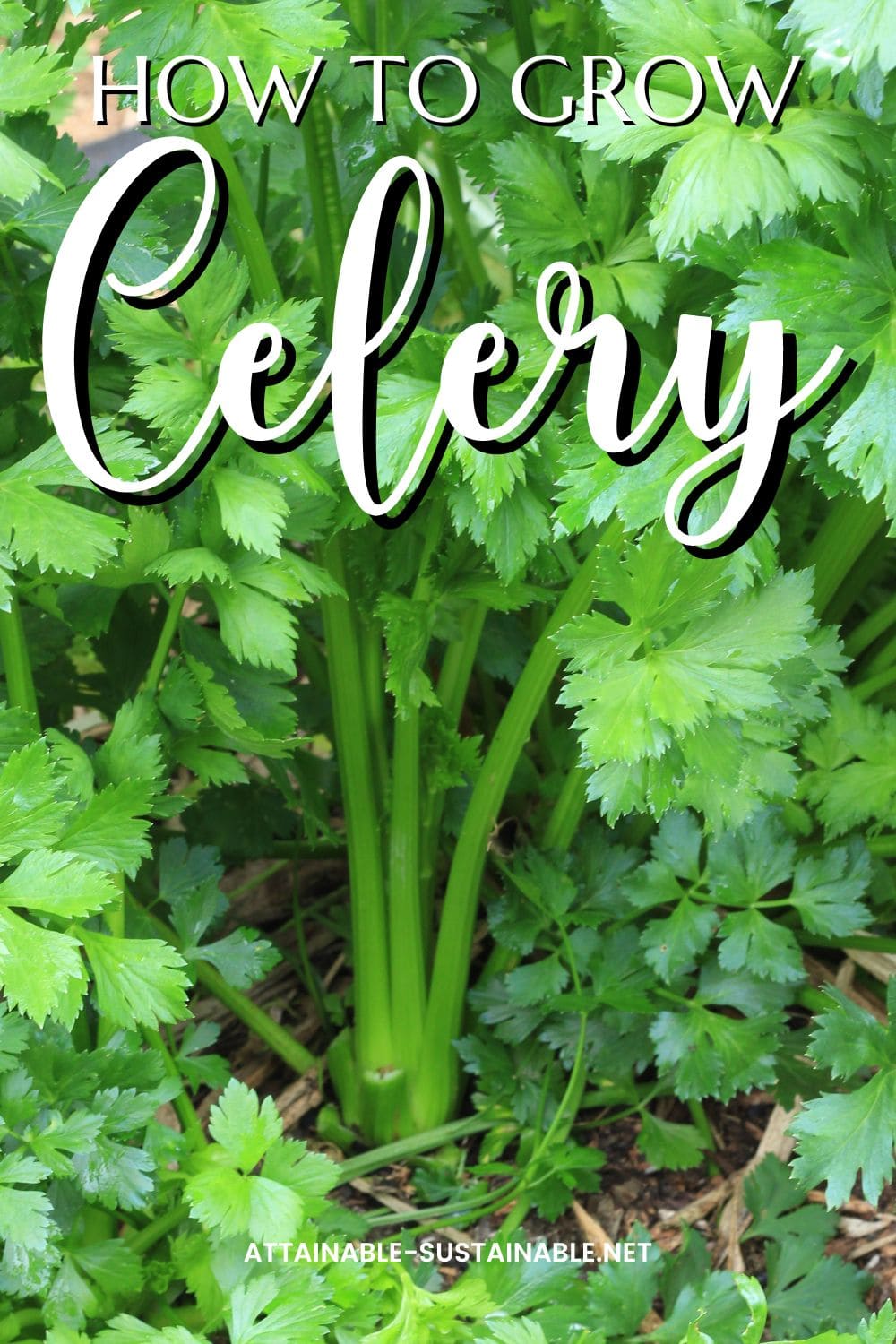
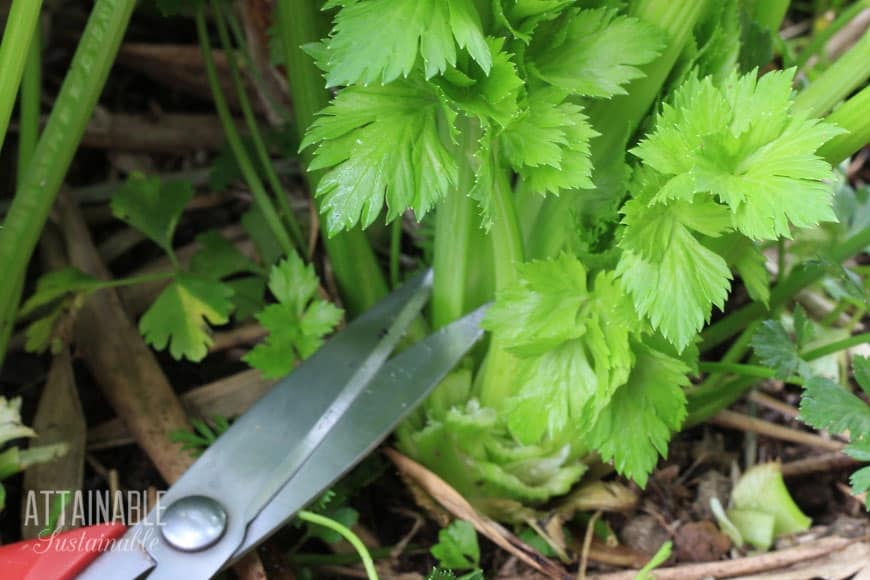
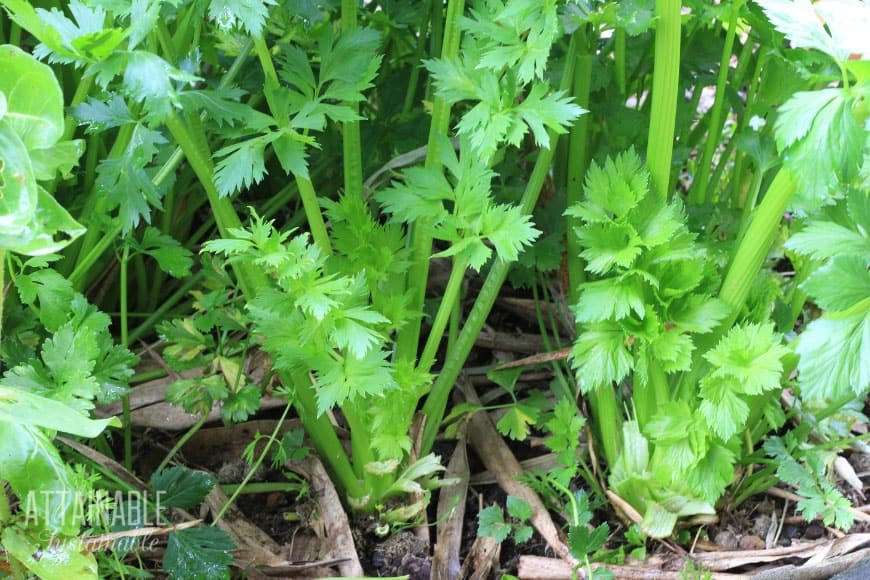
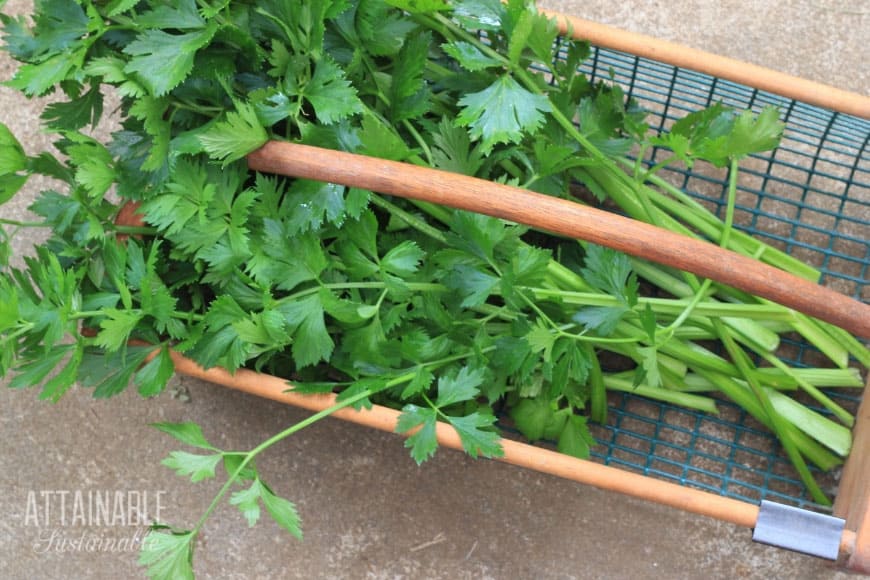





Does celery “bolt”? Maybe I am just unobservant or maybe planted too late and never got to the end of the growing season for celery, but I never saw a seed. I love growing celery and love the ideas for freezing. I do that with rhubarb and other things but never thought about celery. Had a TERRIBLE garden year. Dear ate everything while I was on a one week vacation. This will NOT happen next year. I have a plan.
Celery is a biennial, so it won’t put out seeds until its second year. Good to have a plan! 🙂
Hi I get your facebook posts – many thanks for trhe info & your energy. I use celery leaves in my green smoothy daily & just been advised by sister inlaw – ex Home Ec teacher celery is #1 on a 1-5 poison scale. I can’t find anything to confirm this – your input would be very appreciated. Thanks Chris Nikola
I’ve never heard this. I googled and found this reference: https://www.cfsanappsexternal.fda.gov/scripts/plantox/detail.cfm?id=2931
@christinanikola home grown/organic celery very nutritious- commercial growers spray toxins to prevent bugs destroying their crops which is where the poison rating originates
Homegrown foods are always a great way to make sure they’re free of sprays!
My celery returned voluntarily. I am excited to try it again this year. Thanks for the tips
My celery came back this year voluntarily. I am excited and committed to doing a better job of using it this year. Thanks for all the great tips here.
As I grow the celeries in the country and I stay in town for the winter, I took the celeries
(4 pcs) out of their bed and put them in pots, on my kitchen windowsill. I take the leaves when I need them…
Never thought about freezing it !! great idea !
I normally cut off the leaves, freeze them and then throw them in when making bone broth. A couple weeks ago when I used the last of a bunch of celery I cut the stalks off about 1-2 inches from the base, took it outside and planted it in the garden. I have leaves popping up from it. I just planted another one a couple days ago. Lets see how this one does!
You forgot to mention the seeds and all their worth,
Ah, true!
I chop and freeze the celery for winter consumption. I use a sheet pan, then when frozen place in zip lock. It allows me to grab a handful. I dry the leaves separately, after they are dry I place in zip lock gallon bags and crush when I use them (soups, stews, etc). These stay in the cupboard with a bag of desiccant. I have done this for years.
I have some in my freezer right now!
Hi there please help what is the cause for my celery leaves going yellow
Regards
Have you tried a side dressing of compost?